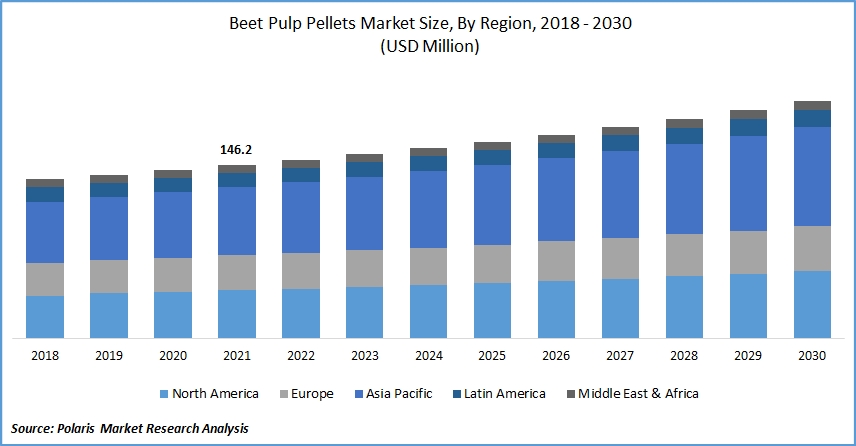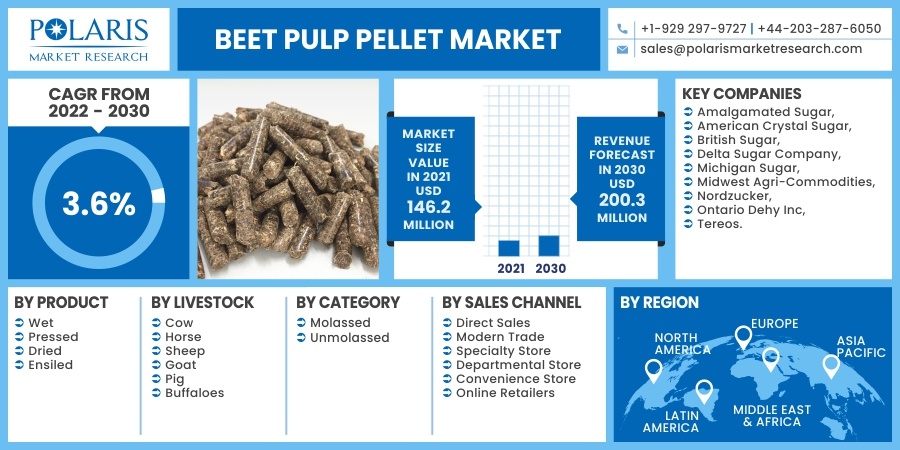
Beet Pulp Pellet Market Share, Size, Trends, Industry Analysis Report, By Livestock (Cow, Horse, Sheep, Goat, Pig, Buffaloes); By Product (Wet, Pressed, Dried, Ensiled); By Category; By Sales Channel; By Region; Segment Forecast, 2022 - 2030
- Published Date:Jan-2022
- Pages: 113
- Format: PDF
- Report ID: PM2165
- Base Year: 2021
- Historical Data: 2018 - 2020
Report Outlook
The global beet pulp pellet market was valued at USD 146.2 million in 2021 and is expected to grow at a CAGR of 3.6% during the forecast period. The global demand for the market is fueled by the rising demand for plant-based goods and the rising popularity of specific diet demands.
 Know more about this report: request for sample pages
Know more about this report: request for sample pages
Beet product demand increases, and industry players are likely to take advantage of the growing organized retail sector to reach a bigger audience. Companies are focusing on large-scale manufacturing and beet pulp to meet the growing demand for nutritional animal feed. Along with this, the demand for improved nutrition in animal feed will become a major development driver. It is a popular energetic feedstuff used for horses in many countries to meet their advanced nutritional needs, which accounts for a large portion of demand in the industry.
Pectin is another commodity derived from a product with a lot of economic interest. For the past few years, the usage of pectin as a popular food stabilizer has greatly broadened the application route. The roughage value of this pellet is appealing because it provides calcium, phosphate, and protein. Sugar is produced in large quantities as a commodity in numerous nations throughout the world, which helps to drive up demand for the industry. The growing commercial importance of this pellet as a fiber source for animal feeding strengthens the industry's prospects.

Know more about this report: request for sample pages
Industry Dynamics
Growth Drivers
The market is most extensively employed in animal husbandry, where these pellets are commonly used to feed horses and other livestock. These pellets are high in protein and vitamins, making them an excellent source of nutrition. They are used in a variety of ways, including directly and as part of other dishes. Horse and livestock owners opt to feed these pellets to their animals on a regular basis to ensure that they receive appropriate nutrition. It contains calcium in very high quantities, which is good for the animals' bones. Because of their nutritional benefits, the demand for such pellets among animal owners continuously increases.
Equine nutrition refers to how animals are fed. The proper and balanced feeding of horses is an important part of effective horse care. This results in gaining popularity among horse owners. The surging demand for the beet pulp pellet market for animal feed worldwide is fueling the industry’s growth.
For instance, as per World Integrated trade Solutions, the Russian Federation has exported 1,279,020,000 Kg of beet-pulp, bagasse, and other residues have risen to 1,347,110,000 Kg, in 2019. This significant growth in production and export quantity of these pellets has augmented the industry growth.
Report Segmentation
The market is primarily segmented based on product, livestock, category, sales channel, and region.
|
By Product |
By Livestock |
By Category |
By Sales Channel |
By Region |
|
|
|
|
|
Know more about this report: request for sample pages
Insight by Product
The dried beet sector is expected to dominate the global beet pulp pellet market. The chemical analysis and nutrient composition of dried pulp reveal that it contains sucrose, calcium, magnesium, phosphorus, natural protein, and a variety of other nutrients, all of which contribute to the health advantages. Furthermore, dry sugar beet pulp can be held in flat storage for longer, allowing clients to feed their stores without hassle. Customers have increased their demand for dried beet pulp for livestock feeding due to this.
Insight by Livestock
Cows will continue to consume the majority of beet pulp, resulting in a significant increase in market revenue. These can be fed to pregnant or lactating cows as a supplement, backgrounding element, or roughage replacement in finishing diets. Furthermore, beet pulp includes a high amount of digestible fiber, and it does not cause acidosis in cows that consume it. Beet pulp has a modest crude protein content of about 8%-10% but a high TDN content of 72%-75%.
Geographic Overview
North America has the largest global beet pulp pellet market share due to the high consumption and production in the region. However, if the pandemic continues unabated, beet pulp pellet sales may suffer in the coming years as a result of economic uncertainty and a lack of product availability. The establishment of new policies for manufacturers and workers and improvements in healthcare facilities will contribute to effective operations.
This could lead to rapid growth in the beet pulp market in the U.S. Veganism is gaining acceptance in the United States, which will continue to boost the market's overall growth. Due to the increased acceptance of such pellets for various applications in this area, such as animal feed, equestrian feed, and others.
Asia Pacific is projected to be the fastest-growing region in the market. The Asia Pacific region dominates the pulp pellets market. Due to the high consumption of dynamic swine feed and dairy feed industries in emerging economies such as India and China, the global market is expected to rise at a high rate. The cattle feed industry is expanding rapidly as milk producers begin to replace traditional cattle feed with more nutritionally balanced compound feed, realizing the actual benefits of nutritional feed in terms of increased yield.
The livestock business is the most important aspect of agricultural development in Asia, and it has grown at an unparalleled rate in recent decades. Because of population growth and rising living standards, the livestock business has been obliged to adapt and expand in order to meet society's expectations by giving healthy animal feed to livestock animals. Further, these pellets have become the most significant components in these countries due to their nutritional value, which includes being high in protein, fiber, and vitamins.
Competitive Insight
Some of the major players operating in the global market include Amalgamated Sugar, American Crystal Sugar, British Sugar, Delta Sugar Company, Michigan Sugar, Midwest Agri-Commodities, Nordzucker, Ontario Dehy Inc, and Tereos.
Beet Pulp Pellet Market Report Scope
|
Report Attributes |
Details |
|
Market size value in 2021 |
USD 146.2 million |
|
Revenue forecast in 2030 |
USD 200.3 million |
|
CAGR |
3.6% from 2022 - 2030 |
|
Base year |
2021 |
|
Historical data |
2018 - 2020 |
|
Forecast period |
2022 - 2030 |
|
Quantitative units |
Revenue in USD million/billion and CAGR from 2022 to 2030 |
|
Segments covered |
By Product, By Livestock, By Category, By Sales Channel, By Region |
|
Regional scope |
North America, Europe, Asia Pacific, Latin America, Middle East & Africa |
|
Key companies |
Amalgamated Sugar, American Crystal Sugar, British Sugar, Delta Sugar Company, Michigan Sugar, Midwest Agri-Commodities, Nordzucker, Ontario Dehy Inc, and Tereos. |

